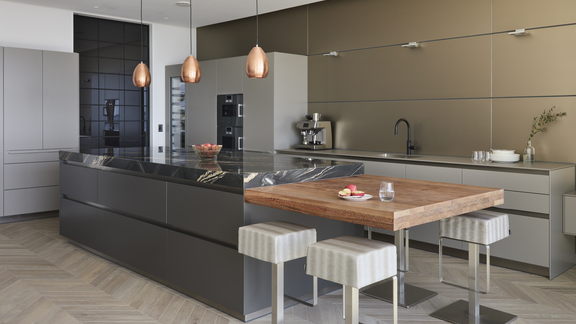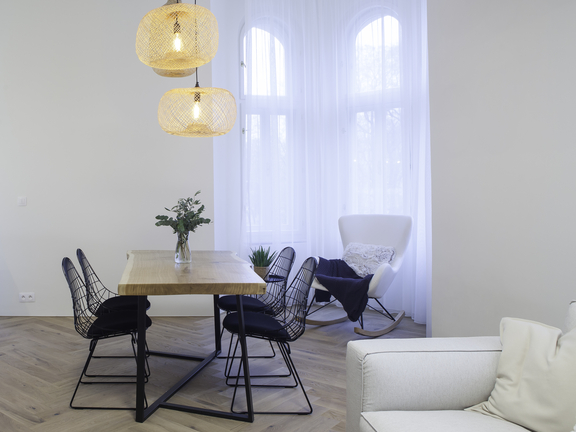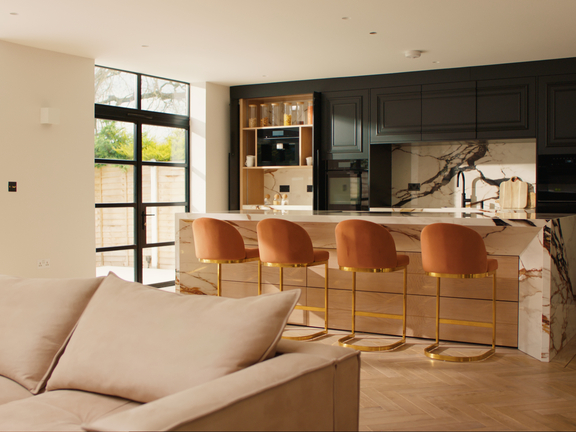

You're clearing out the cupboard while your husband grills steaks, your daughter does her homework at the table and your son scrolls on his smartphone in the armchair in the corner:
In an eat-in kitchen, all family members come together to do a wide variety of things - at any time of day. What used to be common practice is now being rediscovered. A kitchen-cum-living room can usually be easily installed in existing homes - find out how to do it!
Details on kitchen planning
As the name suggests, this living concept combines two important elements: the practical aspect of preparing meals and the homey atmosphere of a space for various activities. In earlier times, this form of cooking was ubiquitous for good reason:

To ensure that heat was available for cooking, a fire of logs or, later, coal was kept burning at all times. The kitchen was therefore always wonderfully warm, while fireplaces and stoves in other rooms were only lit on special occasions. Meals were taken in the dining area of the kitchen-cum-living room and many other everyday tasks were carried out.
The revival of the home kitchen goes hand in hand with the growing interest in high-quality kitchen equipment for preparing delicious dishes and sociable get-togethers within your own four walls with short distances. There are suitable options for every room size.
| Advantages | Disadvantages |
|---|---|
| Flexible utilisation options | Good ventilation and functionality place high demands on planning |
| Short distances between kitchen and dining area | Lack of space: An eat-in kitchen cannot be retrofitted in every home |
| Easy communication with family members or guests while cooking | Increased need for tidiness: untidy kitchen area is immediately visible. |
The room layout is an important aspect when you are furnishing your kitchen-cum-living room. Should it be an open-plan kitchen with a seamless transition between the cooking and dining areas or is it more sensible to separate the two areas? The planning also depends on the size of the room.
A large room that you divide into two halves visually with a kitchen island is ideal. The kitchen unit with sink, oven and cupboards as well as a large refrigerator such as the BORA Cool Combi XL is located along one wall. The hob is integrated into the kitchen island so that you have the dining area in view while cooking.
You can design this as you wish: If you want the kitchen-living room to look modern and minimalist , consider a rectangular anthracite grey table with two sleek benches, illuminated by the innovative BORA Horizon pendant light. If you like it cosy, use a rustic wooden table with colourful armchairs.
Further design options for a large eat-in kitchen:


Don't want to do without a kitchen island despite limited space? Then replace the separate dining table, which takes up a lot of space in the kitchen. Instead, choose a kitchen island that combines the cooking and work area with a raised bar counter, where three or even four people can sit side by side. Would you prefer to sit opposite your partner? A high bar table with two bar chairs also fits into smaller rooms to save space.
If the eat-in kitchen is small, your options are limited, but this doesn't have to stand in the way of a cosy concept. An L-shaped kitchen unit with compact kitchen appliances such as the BORA S Pure hob with integrated extractor on the long side is ideal for the cooking area. The short side serves as a small counter with two bar stools. Here you can take small meals yourself or sit down for a chat with your neighbour over a coffee while you prepare dinner.
Kitchen-living rooms offer a wide range of design options. For example, a style mix with attractive contrasts is suitable for renovations: Combine an old parquet floor and cosy mid-century wooden seating with high-gloss white kitchen units and innovative products such as the modular BORA Classic cooktop extractor system. Also think about unusual decorative elements that enhance the cosy feel: Hang a crystal chandelier above the dining table or place a mid-century display cabinet with books from a second-hand bookshop against a wall.

Are you dreaming of a wonderfully nostalgic country-style kitchen ? Then choose kitchen units with wooden panelling painted in the colour of your choice: It doesn't always have to be white. Soft tones such as light grey, green or rosé lend the room additional cosiness and can be found in the home textiles such as the tablecloth.
Do away with wall units to decorate the walls with cookware on hooks and open shelves . Use green plants to visually separate the dining area in the kitchen-living room from the cooking area. These have a sound-absorbing effect and exude a natural radiance.